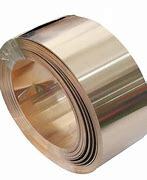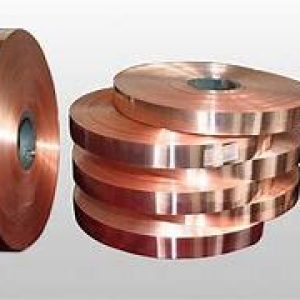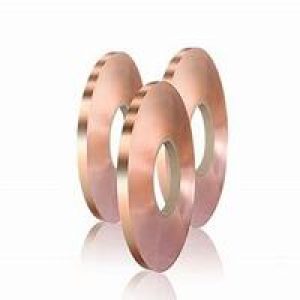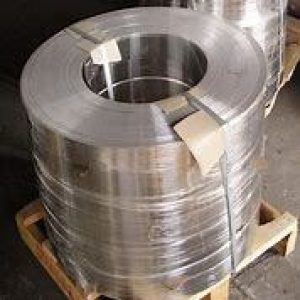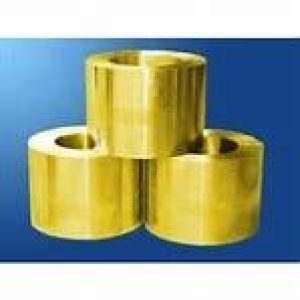Overview of Thin Copper Strip / Copper Foil For Transformer
Copper strip refers to thin, flat, and flexible sheets or strips made from pure copper or copper alloys. Known for their excellent electrical conductivity, thermal conductivity, formability, and resistance to corrosion, copper strips are widely utilized in applications where these properties are of paramount importance. The thickness of copper strips can vary significantly, usually ranging from a few millimeters down to extremely thin foils, while widths can be tailored to suit specific application requirements. Copper strips are commonly manufactured through rolling processes, starting from copper ingots or thicker sheets and progressively reducing their thickness.
Features of Thin Copper Strip / Copper Foil For Transformer
-
High Conductivity: Like copper rods, copper strips offer excellent electrical and thermal conductivity, making them ideal for electrical and electronic components.
-
Formability: Copper strips can be easily bent, folded, or shaped without cracking, which is crucial for complex manufacturing processes.
-
Corrosion Resistance: Copper naturally forms a protective patina that inhibits further corrosion, ensuring its longevity in various environments.
-
Wide Range of Alloys Available: Copper can be combined with other metals to create strips with enhanced properties, such as increased strength, wear-resistance, or specialized thermal and electrical characteristics.
-
Flexibility: The thin and flexible nature of copper strips allows them to conform to curved surfaces or tight spaces, useful in wiring harnesses and compact electronic devices.

(Thin Copper Strip / Copper Foil For Transformer)
Parameters of Thin Copper Strip / Copper Foil For Transformer
Copper is an essential material used in the manufacturing of transformers due to its excellent electrical conductivity and ductility. Thin copper strips or copper foil plays a crucial role in transformer construction, serving as a key component in the core and winding processes. The choice of thin copper strip or foil depends on several factors including the transformer’s size, power rating, efficiency requirements, and cost considerations.
The primary parameter that determines the quality and suitability of a thin copper strip for transformer applications is its thickness. The thickness of the copper foil or strip directly impacts the transformer’s magnetic properties, heat dissipation capabilities, and overall performance. Thinner copper strips can offer higher surface area per unit volume, which can enhance cooling efficiency but may compromise mechanical strength. Conversely, thicker strips provide better mechanical stability and can handle higher current densities but might reduce cooling efficiency.
Another critical factor is the copper’s purity. High-purity copper ensures minimal electrical resistance and superior conductivity, leading to reduced energy loss and improved transformer efficiency. The alloy composition can also be tailored to suit specific application requirements, such as increased corrosion resistance or enhanced mechanical properties.
In terms of mechanical properties, the thin copper strips must possess adequate strength and flexibility to withstand the stresses imposed during transformer assembly and operation without deforming or breaking. Additionally, the strips should have good formability to ensure precise shaping into the required transformer components.
Electrical insulation is another crucial aspect when selecting thin copper strips for transformers. Adequate insulation between layers of copper windings is necessary to prevent short circuits and ensure safe operation. This often involves using varnish, lacquer, or other insulating materials to coat the copper surfaces.
Cost is also a significant consideration, especially for high-volume production of transformers. The cost-effectiveness of thin copper strips can vary based on their quality, availability, and manufacturing processes. Optimal selection requires balancing the need for high-performance materials with economic constraints.
In conclusion, the choice of thin copper strips or copper foil for transformer applications involves careful consideration of parameters such as thickness, purity, mechanical properties, electrical insulation, and cost-effectiveness. These factors collectively determine the transformer’s efficiency, reliability, and overall performance. By selecting the right type of copper strip, manufacturers can ensure that their transformers meet the desired specifications while remaining competitive in the market.

(Thin Copper Strip / Copper Foil For Transformer)
Applications of Thin Copper Strip / Copper Foil For Transformer
-
Electronics Manufacturing: Copper strips are used in printed circuit boards (PCBs), connectors, transformers, and inductor coils due to their high conductivity and ease of processing.
-
Automotive Industry: They are integral to vehicle wiring harnesses, battery terminals, and various electrical components where flexibility and conductivity are required.
-
Building and Construction: Copper strips are used in roofing, flashing, and electrical grounding systems due to their durability and corrosion-resistant properties.
-
HVAC Systems: As part of heat exchangers, evaporators, and condenser coils, copper strips facilitate efficient heat transfer.
-
Telecommunications: Copper strips are found in cable shielding, providing electromagnetic interference (EMI) protection.
Company Profile
Copper Channel is a trusted global metal material supplier & manufacturer with over 12-year-experience in providing super high-quality copper products and relatives products.
The company has a professional technical department and Quality Supervision Department, a well-equipped laboratory, and equipped with advanced testing equipment and after-sales customer service center.
If you are looking for high-quality copper materials and relative products, please feel free to contact us or click on the needed products to send an inquiry.
Payment Methods
L/C, T/T, Western Union, Paypal, Credit Card etc.
Shipment
It could be shipped by sea, by air, or by reveal ASAP as soon as repayment receipt.
FAQs of Thin Copper Strip / Copper Foil For Transformer
Q: What are the standard thicknesses for Thin Copper Strip / Copper Foil For Transformer?
A: Thin Copper Strip / Copper Foil For Transformer can be found in a wide range of thicknesses, typically starting from around 0.1mm up to a few millimeters, depending on the application.
Q: Can Thin Copper Strip / Copper Foil For Transformer be insulated or coated?
A: Yes, Thin Copper Strip / Copper Foil For Transformer can be insulated with materials like PVC, polyethylene, or varnish to protect against environmental factors or to enhance electrical insulation properties.
Q: Is Thin Copper Strip / Copper Foil For Transformer suitable for outdoor use?
A: Absolutely, copper’s inherent corrosion resistance makes it suitable for outdoor applications where exposure to weather conditions is inevitable.
Q: How does Thin Copper Strip / Copper Foil For Transformer compare to copper wires in terms of conductivity?
A: Thin Copper Strip / Copper Foil For Transformer generally has the same level of conductivity as copper wire of the same purity, but their larger surface area can allow for more effective heat dissipation in certain applications.
Q: Are there any specific cleaning or maintenance requirements for Thin Copper Strip / Copper Foil For Transformer?
A: Thin Copper Strip / Copper Foil For Transformer requires minimal maintenance. For cleaning, mild soap and water or specialized metal cleaners can be used, avoiding abrasive materials that might scratch the surface. Regular inspection for signs of corrosion or damage is recommended for critical applications.
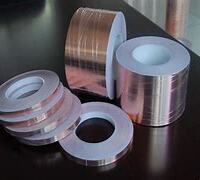
(Thin Copper Strip / Copper Foil For Transformer)
